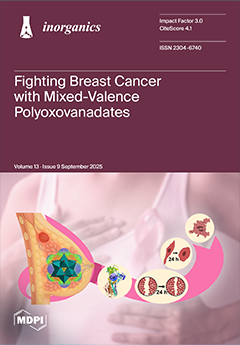Polyoxovanadates are a subclass of polyoxometalates (POMs) known to interact with proteins and to present anticancer, antimicrobial, and antiviral activities. Herein, we aimed to pursue the study of the breast anticancer activity of a mixed-valence polyoxovanadate, [Cl@V
V7V
IV8O
[...] Read more.
Polyoxovanadates are a subclass of polyoxometalates (POMs) known to interact with proteins and to present anticancer, antimicrobial, and antiviral activities. Herein, we aimed to pursue the study of the breast anticancer activity of a mixed-valence polyoxovanadate, [Cl@V
V7V
IV8O
36]
6− (V
15) against MCF-7 and MDA-MB-231 cancer cell lines and to analyze its Ca
2+-ATPase inhibition potential.
51V NMR and UV-Vis/NIR studies of V
15 indicated its stability in HEPES and RPMI media. For the Ca
2+-ATPase activity, V
15 showed an IC
50 value of 14.2 μM and a mixed type of inhibition. The electrostatic potential map of V
15 and other POMs were correlated with the enzyme activity inhibition. V
15 also exhibited cytotoxicity against MDA-MB-231 (IC
50 = 17.2 μM) and MCF-7 (IC
50 = 15.1 μM) breast cancer cell lines. Using V
15 concentrations equivalent to half and 1/4 of the IC
50, it was observed that MDA-MB-231 cell migration was reduced by 90 and 70%, after 24 h, respectively. Moreover, V
15 caused morphological changes from fusiform to an epithelial-like (amoeboid) shape. Finally, V
15 induced the increase in RIPK1, MLKL, and RIPK3 gene expression, up to 3, 10, and 15-fold, respectively, pointing out that the mechanisms of cell death in the triple-negative breast cancer cell line may occur by necroptosis.
Full article





